
W.H.D. Koerner: A Family Legacy – Points West Online
Originally published in Points West magazine
Summer 2008
W.H.D. Koerner: A Family Legacy
By Mindy A. Besaw
W.H.D. Koerner, painter and illustrator, was born in Lunden, Schleswig-Holstein, Germany, and grew up in Clinton, Iowa. A steady contributor at the time of the “Golden Age” of illustration and American popular fiction, he was a highly prolific artist and painted 2,401 published illustrations for more than fourteen popular magazines. In addition, he completed many unpublished paintings for his personal enrichment and enjoyment.
The W.H.D. Koerner studio, opened in 1978, was the first artist’s studio installed and dedicated at the [then] Buffalo Bill Historical Center. Donated and designed by the children of the artist—W.H.D. Koerner III and Ruth Ann Koerner Oliver—the studio was recreated as if Koerner himself had just laid aside his paintbrush and departed for a short break.
Koerner’s studio objects and archives form a cornerstone of the Whitney Western Art Museum’s collection. With this collection, the Whitney has the great advantage of presenting every aspect of Koerner’s creative technique. By sharing this process, from the inception of the idea to the creation of the work, the art becomes accessible to visitors—and in this case, readers. Here is the story of one such artwork: Koerner’s painting, Hard Winter.

In 1932, Koerner was asked to illustrate a serial called “Short Grass” by Hal G. Evarts for the magazine Saturday Evening Post. Evarts’s fictional tale about the final glory days of the open range was particularly suited to Koerner’s artistic sensibility and deep interest in the American West.
Koerner’s first step in the creative process was to read the manuscript and take notes on the setting, time, and characters. Next, even before touching pencil to paper, Koerner researched his subjects to insure accuracy in his details and portrayal of the American West. His research was based on first-hand experience during travels in the West as well as research at the New York Public Library, the Museum of Natural History in New York, and his personal library.
The family’s sojourns to the western states, starting in 1922, were particularly inspirational to Koerner. Each trip provided the opportunity to collect artifacts, costumes, and accessories related to the people of the West, as well as photographs and sketches of the landscape. Koerner’s Interlaken, New Jersey, studio was filled with his western souvenirs and props, which acted as constant reminders of the western experience.
Once the research was complete, Koerner prepared several “comps” with pencil to determine the final composition of the painting. When satisfied with the composition and general impression of the image, he used models occasionally to verify his composition and capture details such as the way light reflected on folds of clothing. For this particular painting, Koerner enlisted the assistance of his son Billy for the central figure.
Billy still vividly recalls the hot July day when his father told him about his latest painting. His father asked Billy to join him after lunch to pose wearing a costume of a cattleman in a driving blizzard. “Imagine posing for a freezing snow scene wearing a heavy cowboy costume when the studio interior was over a hundred degrees blistering hot!” Billy would later exclaim.

But, always willing to help, he did pose in many layers of clothing—riding pants, a heavy shirt and coat, cowboy boots, orange angora woolen chaps, jangling spurs, a slouched hat, and a shaggy scarf tied to his head. Then, according to Billy, it was quite a trick “to mount my bronco horse without getting all tangled up in all the western saddle straps and rope, which had been cinched on a barrel on top of a wooden frame.”
While posing in the sweltering heat, Billy occupied his mind with the vision of a cold and stormy night. In fact, only a few years earlier, he and his father had experienced driving cattle in the harsh cold blizzard of Montana during a 1927 spring roundup. Koerner then snapped a few photographs and made several quick sketches of the pose.
There was one more step before Koerner started his final painting—a preliminary color composition sketch. Then finally, with his reference material of sketches, photographs, and color study, Koerner stretched the canvas and poised his paintbrush. In one week, Koerner completed three paintings of this subject, including the full oil painting, a vignette, and a head study.

Koerner’s wife, Lillian, then drove the paintings directly to the Saturday Evening Post office in Philadelphia. When the serial and illustrations were published, this painting reached a wide audience and was enjoyed by readers across the country.
Although W.H.D. Koerner died in 1938, he left a significant legacy for future generations. He will always live on in the memory of his family, collectors, and the studio collection at the historical center.
In 2008, after thirty years on view, the Koerner studio installation was removed from the Whitney. The Koerner studio objects are being closely examined, cleaned, and conserved to preserve the objects for the future. Select examples of Koerner’s work can be enjoyed in the Whitney,.
Mindy Besaw is the former John S. Bugas Curator of the Whitney Western Art Museum. She and the Points West staff would like to sincerely thank W.H.D. Koerner III (Billy) and his daughter Diane Koerner Schwartz for sharing their stories and enthusiasm.
Post 203
Written By
Nancy McClure
Nancy now does Grants & Foundations Relations for the Center of the West's Development Department, but was formerly the Content Producer for the Center's Public Relations Department, where her work included writing and updating website content, publicizing events, copy editing, working with images, and producing the e-newsletter Western Wire. Her current job is seeking and applying for funding from government grants and private foundations. In her spare time, Nancy enjoys photography, reading, flower gardening, and playing the flute.











